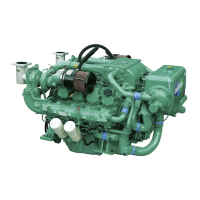- 16 -
Installing (Mounting) the Controller and Cautions
1. Install the controller vertically on the face of the control panel, away from water or moisture, and be careful
that heat from heating elements near the controller is not transferred to it.
2. Also, in the event that it is exposed to moisture for an extended period of time (over one month or dew
condensation), it may not reach the rated rpm due to a change in the resistance value of the internal cir-
cuit caused by exposure to moisture, so dry it off sufficiently before using it.
3. Do not rely exclusively on the function of the actuator in the electronic governor to prevent overspeeding. It is
recommended to install a second, independent engine stopping device, such as a fuel shutoff solenoid.
4. Regarding setting each Doosan engine to the average set range depending on the type of engine, the
indications for the set range on the front of each adjustable resistor recommend the settings within the set
range.
EMC (Electromagnetic Compatibility)
In order to minimize damage to the controller due to unnecessary nearby electromagnetic waves, either
mount the controller on a grounded metal surface or use a shielded metal case. All wires should be
shielded and the shielded part should be grounded to a single point. We cannot provide guarantees for
any EMC-related product quality issues arising in the case that the above-mentioned installation method
for preventing electromagnetic waves is not performed.
Description of Control Mode Items
In order to minimize damage to the controller due to unnecessary nearby electromagnetic waves, either
mount the controller on a grounded metal surface or use a shielded metal case. All wires should be shielded
and the shielded part should be grounded to a single point. We cannot provide guarantees for any EMC-
related product quality issues arising in the case that the above-mentioned installation method for preventing
electromagnetic waves is not performed.
1. Items for auxiliary (emergency) control mode
(1) Speed control resistor: Controls the engine’s running speed.
(2) Gain control resistor: Controls the gain (sensitivity).
(3) Stability control resistor: Controls the stability (responsiveness).
(4) Starting fuel control resistor: Controls the amount of fuel when the engine is started.
(5) Speed ramping control resistor: Controls the time it takes to reach the rated speed after starting the engine.
(6) Idle control resistor: Controls the initial engine speed.
(7) Droop control resistor: Controls the amount of droop (%) during droop operation.
(8) Differential control switch (dip switch): A control switch for selecting differential functions.
(9) Overspeed lamp control resistor: Controls the activation timing of the engine speed lamp and relay.
(10) Run lamp control resistor: Controls the activation timing of the engine operation lamp and relay.
(11) Crank lamp control resistor: Controls the activation timing of the initial speed indicator lamp and relay.
(12) TB1: A terminal block for external input/output wiring connections.
(13) TB2: An output terminal for the engine overspeed relay contact. (Capacity - 2 A/125V AC).
(14) TB3: An output terminal for the engine operating speed relay contact. (Capacity - 2 A/125V AC).
(15) TB4: An output terminal for the initial engine speed relay contact. (Capacity - 2 A/125V AC).

